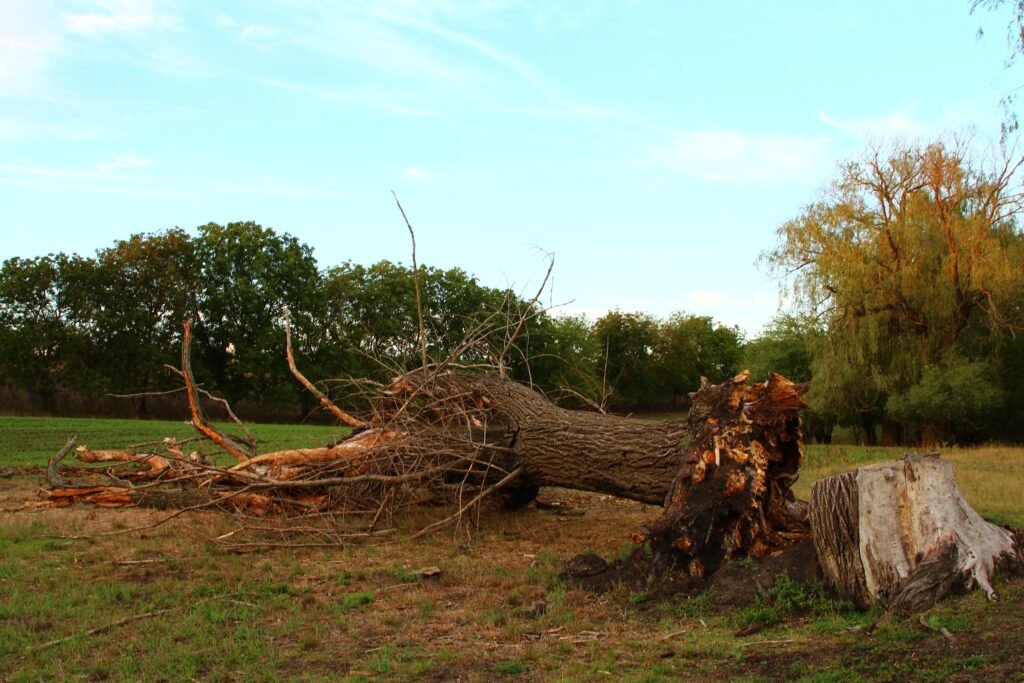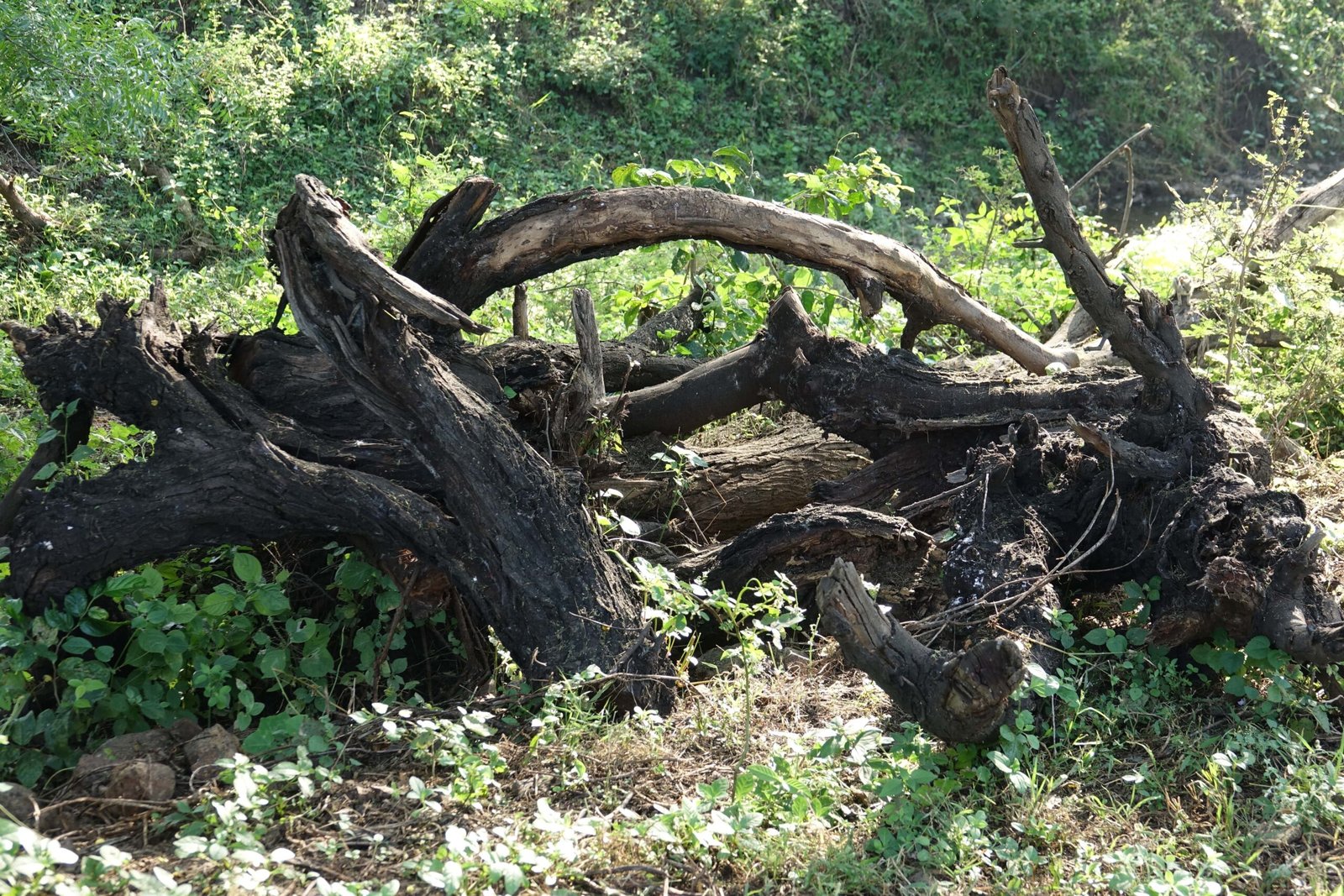So, you’ve got a fallen tree in your yard. Maybe it was knocked down by a storm or simply gave up the ghost after years of standing tall. Whatever the reason, you’re left with a mess that could be a safety hazard and a real eyesore.
You might be wondering, “How much does it cost to remove a fallen tree?” Well, don’t worry, I’ve got you covered!
In this guide, I’ll break down the costs of fallen tree removal, walk you through what factors influence the price, and help you decide if DIY is the way to go or if it’s better to call in the professionals.
By the end, you’ll have a good idea of how to budget for your tree removal needs and maybe even save some cash along the way.
What is Fallen Tree Removal Cost, and How to Differ by Species?

When a tree falls, it’s not just about cutting it up and hauling it away. The cost of removing a fallen tree depends on several factors, one of the biggest ones being the species of the tree.
Some trees are easier to remove, while others can be tougher because of their size, wood type, or how they’ve fallen.
For example, Eucalyptus trees are big and sturdy, so their removal is usually more expensive than something like a Bottlebrush Shrub, which is much smaller.
Here’s a quick breakdown of what you might pay for tree removal, depending on the type of tree:
| Type of Tree | Average Removal Cost |
| Eucalyptus (Gum Trees) | $1,200 – $5,000 |
| Liquidambar | $800 – $2,500 |
| Jacaranda | $500 – $1,800 |
| Conifers | $950 – $4,500 |
| Lilly Pilly | $350 – $1,250 |
| Bottlebrush Shrub | $250 – $950 |
| Norfolk Pine | $1,100 – $1,900 |
| Angophora | Around $1,000 |
| Casuarina | $650 – $1,500 |
As you can see, the removal cost varies a lot depending on the tree species. Bigger trees, or those with thicker wood, are going to cost more.
Note: always remember to get a professional quote to avoid any surprises!
Average Fallen Tree Removal Costs
Alright, now let’s get to the juicy part: How much does it cost to remove fallen trees?
Generally speaking, tree removal costs range from $100 to $600 for small to medium-sized trees.
But, here are the things that costs can skyrocket depending on the tree’s size, location, and the challenges presented by its condition.
- Basic Removal (Small to Medium Trees): For most trees under 30 feet, expect to pay somewhere in the $100 to $600 range. These trees are usually fairly easy to remove, and standard equipment will do the job.
- Larger Trees or Difficult Access: Got a 60-foot oak or a huge pine tree that’s fallen in a tricky spot? This is where the cost can go up. For big trees or those located in hard-to-reach areas (hello, backyard jungle), removal can run $1,500 or more. The equipment needed, like cranes or bucket trucks, and the extra manpower will jack up the price.
| Tree Size | Average DIY Cost | Average Professional Cost |
| Small (Up to 15 ft) | $100 – $200 | $150 – $500 |
| Medium (16 – 30 ft) | $200 – $400 | $300 – $1,000 |
| Large (31 – 60 ft) | $300 – $600 | $500 – $1,500 |
| Very Large (61+ ft) | $500 – $800 | $800 – $2,000+ |
Factors Influencing the Cost of Fallen Tree Removal
Now that you know the basic costs, let’s dive into the factors that influence how much you’ll be paying. It’s not always as simple as just chopping the tree down.
| Factor | Cost Range (DIY) | Cost Range (Professional) |
| Tree Size (Small: Up to 15 ft) | $100 – $300 | $150 – $500 |
| Tree Size (Medium: 16 – 30 ft) | $200 – $500 | $300 – $1,000 |
| Tree Size (Large: 31 – 60 ft) | $400 – $800 | $800 – $1,500 |
| Tree Size (Very Large: 61+ ft) | $500 – $1,000 | $1,000 – $2,000+ |
| Location (Easy Access) | $100 – $300 | $200 – $600 |
| Location (Difficult Access) | $300 – $600 | $500 – $1,200 |
| Fallen Tree | $100 – $300 | $200 – $1,000 |
| Emergency Removal | $200 – $600 | $500 – $2,000+ |
| Condition (Dead or Diseased) | $200 – $400 | $400 – $1,500 |
| Stump Grinding | $50 – $200 | $150 – $400 |
Tree Size & Type
The larger the tree, the higher the cost. But it’s not just size—certain types of trees (like oak or pine) are tougher to remove, which can also add to the price. Think about it: harder woods take more time and effort to cut down.
Location
Is the tree near power lines, your house, or your car? If it’s sitting near something valuable (or dangerous), removal becomes more complex and pricey. The more accessible the tree is, the easier and cheaper the removal will be.
Condition of the Tree
A dead or diseased tree is more unpredictable than a healthy one. You can imagine that cutting down a tree that’s already unstable or on the brink of collapse is a whole lot trickier (and more expensive) than a nice, healthy one. Plus, you’ll probably need extra equipment to ensure no one gets hurt.
Emergency Situations
Storm damage? Emergency tree removal usually comes with a much higher price tag due to the urgency and equipment involved. If you need it done yesterday, expect to pay more.
Fallen Tree Removal Cost Per Acre
For those with larger properties, the cost of removing multiple fallen trees can be calculated per acre. If you’re working with a big yard or dealing with several trees, this approach can sometimes save you some cash, as tree removal services often charge less when multiple trees are being removed from a single area.
| Factor | Cost Estimate | Description |
| Small Trees (Under 30 ft) | $1,000 – $2,000 per acre | Costs for removing smaller trees that are easy to access and don’t require heavy equipment. |
| Medium Trees (30-60 ft) | $2,500 – $4,500 per acre | Removal costs increase as tree size and complexity rise. Includes larger equipment for cutting and hauling. |
| Large Trees (Over 60 ft) | $5,000 – $8,000+ per acre | Removal costs soar for large trees with difficult access, often requiring cranes or specialized tools. |
| Difficult Access Areas | Additional $500 – $2,000 | Additional costs for hard-to-reach areas, such as near power lines, steep slopes, or confined spaces. |
This is particularly helpful for farm owners or anyone managing a big property with trees that fall regularly.
DIY vs. Professional Tree Removal Costs
Now, we know what you’re thinking about DIY vs Professional. Grabbing a chainsaw and tackling the job yourself is tempting, right? But before you go hacking away at that tree, here’s a little reality check.
DIY Tree Removal:
- Costs: You’ll save on professional fees, but trust me, you’ll need some serious tools like a chainsaw, safety gear, and maybe even a stump grinder. Let’s not forget the time it takes. Removing a tree isn’t a 30-minute task.
- Risks: There are risks, folks. Without the proper training and equipment, you could be putting yourself (and your property) at serious risk. Not to mention, DIY tree removal is physically demanding and could lead to some major accidents.
Professional Tree Removal:
- Expertise: The pros have the experience and tools to do the job right and safely. They’ve seen it all and have the gear to deal with tricky situations.
- Safety: Professionals will ensure that no one gets hurt, and the tree doesn’t fall the wrong way (hopefully crushing your fence or car in the process).
- Cost: Hiring a pro will cost more, but in the long run, it’s probably cheaper than the potential damage you’d cause trying it yourself.
| Tree Size/Type | DIY Removal Cost | Professionals Cost |
| Small Tree (up to 15 ft) | $100 – $300 | $150 – $500 |
| Medium Tree (16 – 30 ft) | $200 – $500 | $300 – $1,000 |
| Large Tree (31 – 60 ft) | $400 – $800 | $800 – $1,500+ |
| Very Large Tree (61+ ft) | $500 – $1,000 | $1,000 – $2,000+ |
| Fallen Tree Removal | $100 – $500 (depending on accessibility) | $200 – $1,500+ |
How to Choose the Right Tree Removal Service?
When it comes to hiring a tree removal company, don’t just pick the first one you find. Here’s what to look for:
- Licensing and Insurance: Make sure they’re fully insured and licensed. Accidents happen, and you don’t want to be left paying for someone else’s mistake.
- Experience: Look for a company with a track record of successful removals. Check reviews or ask for references.
- Quotes: Get multiple quotes, but don’t just go with the cheapest option. Consider the quality of service and the safety measures in place.
Cost of Tree Removal Related Services
Along with fallen tree removal, you might need to budget for additional services. Tree trimming might cost you between $100 and $1,200, depending on the size and type of tree.
Stump grinding, which you’ll likely need after the tree is down, can cost between $100 and $400.
If you’re thinking about moving a tree rather than removing it, tree transplanting could cost between $200 and $1,000, depending on the size.
How to Save Money on Tree Removal?
Who doesn’t love saving a few bucks? Here are some tips to keep costs down:
- Get Multiple Quotes: Always shop around for quotes. Prices can vary, and it’s worth comparing.
- Bundle Services: If you need tree trimming or stump grinding, see if you can bundle services for a discount.
- Off-Season Removal: Tree removal services tend to be cheaper in the off-season (fall and winter), so if you can wait, you might save some cash.
Final Thoughts
The knowledge of how much to remove fallen trees and what factors impact the price will help you make an informed decision. Whether you decide to handle it yourself or hire a professional, always prioritize safety.
If you have a large or hazardous tree, it’s best to get an expert to handle it. Take the time to get multiple quotes, check reviews, and choose a reputable company.
FAQs
A large tree can cost anywhere from $1,000 to $1,500 or more to remove, depending on the size and complexity of the removal.
It’s possible but not recommended. Tree removal is dangerous and requires specialized equipment. It’s better to hire a professional to ensure safety.
Fallen tree removal generally costs $100 to $600, depending on tree size and location.
Factors include tree size, location, accessibility, tree condition, and whether it’s an emergency.
For small trees in inaccessible areas, it’s possible to remove them without heavy machinery. However, larger trees or tough locations typically require specialized equipment like cranes or bucket trucks.



